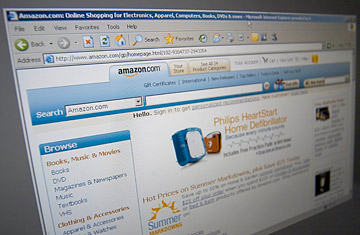
Amazon.com
(2 of 2)
Adding to the iPad threat is a dispute over e-book pricing. Apple signed deals that allow publishers to set the prices in Apple's iBooks store, and new e-book best sellers are expected to be priced at $12.99 to $14.99 — which is considerably higher than Amazon's $9.99 price. Publisher Macmillan is already pressuring Amazon to offer similar pricing. It demanded the right to set prices on Amazon, causing an angry Amazon to pull all of Macmillan's books from its site. However, two days later, amid a firestorm of debate, Amazon indicated that it would agree to Macmillan's demand.
Analysts worry that higher e-book pricing could eat into demand for Amazon's Kindle. "They're trying to build the iTunes for books with their Kindle, so they're particularly sensitive about market share for books," says Sebastian.
That said, the higher e-book price could actually benefit Amazon's bottom line. "At $9.99, Amazon wasn't making any money," says Hamed Khorsand, an analyst at BWS Financial. "So for Amazon to be forced to sell a product at $12.99, they're basically being allowed to make a profit." If prices continue to escalate higher though, it could be a problem, analysts say.
Amazon's stock took a hit in the wake of the iPad launch and book-pricing dispute, falling 9%, although it has since partially recovered. Some analysts believe the sell-off was overblown. "I think the Street is making a bigger noise out of it than it really is," says Khorsand.
Even if the Kindle does lose market share, it only accounted for about 2% to 3% of Amazon's total revenue in 2009, and is only projected to represent 6% in 2010, says Douglas Anmuth, a director at Barclays Capital.
Instead, many analysts see Amazon's biggest growth coming from its international operations, expansion into new merchandise and the addition of more third-party sellers. Its November acquisition of online shoe giant Zappos, for example, contributed $200 million of revenue to the company's fourth quarter. The number of active third-party sellers rose 27% to 1.9 million, and revenue from international sales climbed 49% to $4.56 billion in the latest quarter.
Some see Amazon's biggest growth coming from further expansion into electronics, apparel and consumer products, ranging from shampoo to groceries. Amazon's ability to cross-sell products to existing customers is powerful. "When you've got an account opened at Amazon and they have your credit-card information and they also happen to have some of the lowest prices, it's very easy to start buying on Amazon items that may be outside people's traditional products that they buy online," says Sebastian. "I've been buying diapers from Amazon — not just the books that I would have bought 10 years ago."
Still, Amazon isn't without risk.
Up until now, online retailers have been reaping the benefits of not having to charge customers state taxes in all but about four states. However, a movement is afoot to change that through a streamlined sales tax. "If successful, you'd lose the pricing advantage they have vis-à-vis the bricks-and-mortar stores," says Sebastian.
Then there's the free shipping that's often offered, which experts believe cannot be offered forever. "If energy costs go up and transportation costs continue to rise, that's got to get paid for," says Bill Martin, co-founder of ShopperTrak, a research firm that tracks shoppers.
Amazon's shares recently traded at $115.85 a share. Anmuth has a 12-month price target of $165 on the stock while Khorsand is even more bullish with a $200 target. "I think there's considerable upside from here," says Khorsand. "They have a level where operating margins are tracking above 5% in 2010 and that provides them with a level of cash flow and earnings that would support a $200 stock price."
